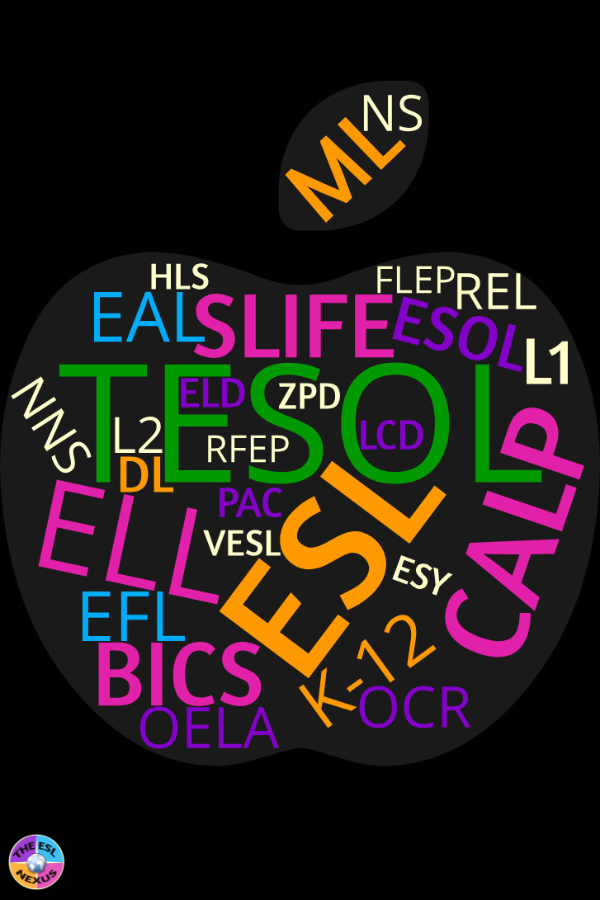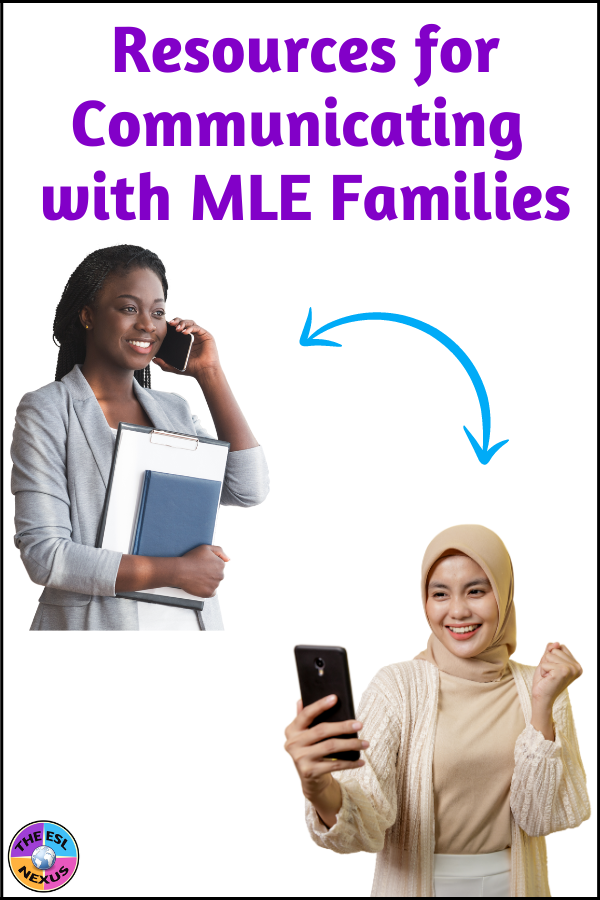There are loads of acronyms about ESL and ELLs and teaching English to students. So as most American students head back to school over the next several weeks, I’d like to offer a list of 40 common acronyms in English language teaching used in the United States. It’ll be particularly useful for educators who don’t work primarily with English Language Learners and who, therefore, may not be familiar with many of these terms.
The list is in A-B-C format with, for the most part, one phrase for each letter. But in some cases, when several acronyms are frequently used, more than one term is presented. And for a couple letters, a word is given instead because there isn’t an abbreviation for those letters. Also, for the letter X, it’s the second letter in the phrase since that letter doesn’t have an ESL acronym for it, either.
If you’d like to download a copy of the list, you can find a link at the end of this blog post.
 |
| ESL acronyms word cloud created by The ESL Nexus with WordClouds.com |
LIST OF ESL ACRONYMS
(By the way, I’m using ESL just because it’s a common term that teachers in the U.S. use both for students learning English and the programs that teach them. However, there are several other ways to describe people who are learning English, as you’ll see below.)
A = ACCESS for ELLs
The Assessing Comprehension and Communication in English State-to-State for English Language Learners is a test for assessing students’ language proficiency
B = BICS
Basic Interpersonal Communications Skills refers to social and interpersonal language used by students
C = CALP
Cognitive Academic Language Proficiency refers to content-area language used in school subjects, in contrast to BICS
C = CBI
Content-Based Instruction means teaching English through teaching academic subjects to students and incorporating English language skills into lessons
D = DL
Dual Language refers to programs that teach academic content in 2 languages; typically the home language of students and the target language
E = EAL
English as an Additional Language is one way of referring to the teaching of the English Language to people for whom it is not their first language
E = EFL
English as a Foreign Language is the term used to describe teaching English in places where English is not the majority, dominant language
E = ELD
English Language Development refers to teaching the English language to students who are learning to speak, read, write, and listen in and to English
E = ELL or EL
English (Language) Learner is a term commonly used to describe someone who is in the process of learning English because it is not their first language
E = ESL
English as a Second Language describes a person learning English or the program used to teach the language; the term ELL is often used instead now
E – ESOL
English as a Second Language is an umbrella term that encompasses ESL and EFL
F = FLEP
Former Limited English Proficient describes a student who used to be an English Learner but was reclassified because they are now more or less fluent in English
G = GE
General Education is not an ESL-specific term; it refers to regular education ads mainstream classes, in contrast to special education or ESL classes
H = HLS
A Home Language Survey is filled out by families when registering new students for school; it is used to help determine if a student might need ESL support
I = IPA
The International Phonetic Alphabet uses letters and symbols to teach pronunciation and is not dependent on people already knowing how to speak English
J = Jargon
Not an acronym but educators can see that the field of English Language Teaching is filled with specialized terms that are important and useful to know
K = K-12
Not specific to English Language Teaching, but Kindergarten to 12th grade is frequently used by educators
L = L1 and L2
Refers to the first language (L1) and the second language (L2) of students; i.e. the L1 may be Spanish and the L2 is English
L = LCD
Linguistically and Culturally Diverse students may or may not be English Learners; the term includes all students from a variety of backgrounds
L = LTEL
A Long-Term English Learner is a student who has been in an ESL program or has been learning English for at least 6 years but still is not considered proficient
M = ML
Multilingual Learner is a phrase that is starting to supersede ESL and ELL to describe people learning English; some people think it is more additive than the other terms
M = MPI
Developed by WIDA, a Model Performance Indicator is an example of how English can be used in a language domain for a grade level and a proficiency level
N = NABE
The National Association for Bilingual Education is a professional organization working to promote bilingual and multilingual learners and education
N = Newcomer
Not an acronym; a Newcomer is a student who has recently arrived in the U.S. and is at a beginning level of English language proficiency
N = NNS and NS
These terms distinguish between a Non-Native Speaker of English and a Native Speaker of English
O = OCR
The Office of Civil Rights investigates problems and issues related to the teaching of English Learners and makes sure that the relevant laws are followed
O = OELA
Part of the U.S. Department of Education, the Office of English Language Education is responsible for policy matters regarding the teaching of English Learners
P = PAC
A Parent Advisory Council, which should include EL families, is a group that meets and offers suggestions for improving education in the school district
Q = Quality
Not an acronym nor an education-specific term, but educators should keep in mind that English Learners are entitled by law to a quality education
R = REL
The Regional Education Laboratory Program includes 10 organizations around the U.S. that offer materials on various aspects of education, including ELL teaching
R = RFEP
A Reclassified Fluent English Speaker, this is another phrase used to describe an FLEP (Former Limited English Proficient) student; these students are typically followed for 2 years to ensure they are making progress in school and no longer need ESL support
S = SI
Sheltered Instruction is an approach to teaching a class of English speakers and ELs that incorporates strategies for making the content more comprehensible to ELLs
S = SLIFE or SIFE
Students with Limited or Interrupted Formal Education have never been to school or have big gaps in their education and need special programs to help them
S = SIOP
The Sheltered Instruction Observation Protocol® is an approach to teaching students in regular ed classes that combines language and content in lessons
T = TESOL
Teaching English to Speakers of Other Languages refers to educating ELLs; it also refers to the professional organization TESOL International Association
U = UbD
Not an ELL-specific term, Understanding by Design is a way of teaching that starts by deciding what to assess and then figuring out the lessons to teach that material
V = VESL
Vocational English as a Second Language refers to teaching the English used in specific jobs, such as the tourism industry or medical field
W = WIDA
Now known as the WIDA (World-Class Instructional Design and Assessment) Consortium, it creates K-12 standards and materials for teaching English Learners
X = ESY
An Extended School year program operates throughout the calendar year, rather than just the more typical August-September to May-June school year
Z = ZPD
The Zone of Proximal Development refers to how much a student can do on their own and how much they can do with support; it is useful for scaffolding learning
If you’d like a copy of this list of acronyms used in the ESL/ELL field, you can download it HERE. Feel free to share it with your colleagues!




